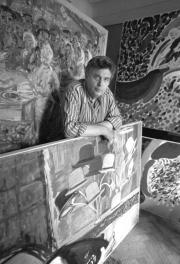
Zlotnikov studied at the Moscow Middle Art School for especially gifted children and attended the sculpture studio at the Golubkina Museum. He was an apprentice at the Bolshoi Theater in 1954-1955. He free-lanced designing at the Economic Achievements Exhibition park and illustrated books for Moscow publishers. He began his extensive travels around the USSR in the early 1960s. Zlotnikov started exhibiting his work in 1962, and ten years later was accepted in the Union of Artists USSR. There was a modest solo show at the Tretyakov Gallery in 2004. The Moscow Museum of Modern Arts held a major retrospective in 2011. Zlotnikov lives in Moscow. An interest in Fauvism marked the early period of developing a contemporary style. Then Zlotnikov and his school friend, the artist and mathematician Vladimir Slepyan, became admirers and popularizers of the works of Oleg Tselkov. Later, the two became science enthusiasts and sought artistic analogies for the latest scientific discoveries. Slepyan turned to Surrealism, Zlotnikov to expressive abstract work. Influenced by the advances in nuclear physics, Zlotnikov created his first abstract work, “Geiger Counter.” The further development of his own style came in the circle of artists who gathered in Slepyan’s studio (Boris Turetsky, Igor Kukles, and Oleg Prokofiev). In their research and happenings, they elaborated new forms of abstract art as the language of a future scientific and technological civilization and achieved lapidary forms of a purist style. For Zlotnikov the result of their collaboration was the “Signal System,” imbued with his study of Piet Mondrian and Kazimir Malevich. The artist perfected it in several series of drawings in 1957-1962. The foundation of the work on these series is the study of cybernetics, analysis of human psychology, tactile sensations, and the communicative possibilities of abstract art. After Slepyan fled to the West and the circle fell apart, Zlotnikov returned to figurative Cézannist painting in the early 1960s. He painted a series of self-portraits, as well as genre pieces and landscapes. A pendulum swing from abstract work to figurative and back again characterizes his creative path. In the late 1960s, he was back in nonfigurative work, but this time in Abstract Expressionism imbued with the early period of Kandinsky’s work. Zlotnikov’s connection to this tradition is evinced by his persistent attempts to convey musical sounds, as well the echoes of late symbolism, the motifs of mass movement of people, cathedral ceremonies, flights of spirits, all conveyed in an extremely schematic manner. In recent years, he is increasingly interested and impulsive, automatic, and naïve drawing in abstract improvisations. Zlotnikov, the patriarch of nonconformist art, is still actively working.